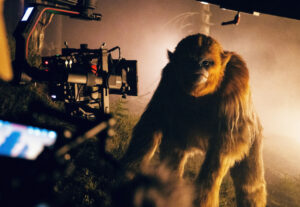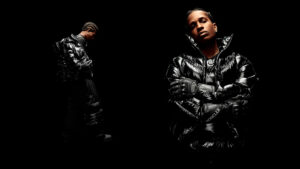

In a cinematic era dominated by digital effects, motion capture suits, and green screens, The Legend of Ochi arrives like a creature from another time—both ancient and tactile. Directed by Isaiah Saxon and produced by A24, the film doesn’t merely tell a story of connection between a young girl and a mythical creature—it builds that connection in real material, animatronic servos, tactile puppetry, and vocal performances conjured from human breath, bird calls, and the eerie echoes of whales. Ochi, the title creature, isn’t a digital phantom. Ochi is real—at least in the most cinematic sense of the word.
But how does one build a myth from scratch? The creation of the Ochi was as much an act of natural science as it was narrative myth-making. Saxon’s devotion to realism, imagination, and emotional resonance yielded one of the most memorable screen creatures of the decade—neither alien nor wholly terrestrial, but something that rests in the uncanny valley of folklore. From deep dives into obscure biological databases to the recruitment of YouTube bird-callers, the Ochi is the culmination of years of world-building, wiki-digging, and biomechanical craftsmanship. This is the story of how a creature was born not on a render farm, but on a puppeteer’s arm.
A Primal Spark: Drawing from Nature, Not Fantasy
Saxon didn’t start with the Ochi’s design as a fantasy creature; he started with the real world. Specifically, he fixated on real endangered species—those that almost look too magical to exist. The golden snub-nosed monkey, with its cerulean face and saffron coat, served as one of the primary references. Its anatomy—delicate hands, stoic eyes, and quizzical expressions—provided Saxon with a foundation of believability.
From there, the tarsier, known for its enormous eyes and twitchy movements, added another layer of visual grammar. Saxon wasn’t interested in designing a generic “cute” creature. He wanted a creature you might find in a corner of the world you’ve never visited—a “cryptid of conscience,” as one puppeteer called it. It’s a method that echoes Jim Henson’s design principles: if a creature looks like it could plausibly be hiding in a rainforest somewhere, audiences will emotionally invest in it.
Saxon’s interest in biomes and ecosystems drove the world-building of the film. Unlike so many high-fantasy environments that feel like video game backdrops, the landscapes of The Legend of Ochi feel textured, interconnected, even ecological. The Ochi belongs to this world not by coincidence, but by genetic implication.
Animating the Uncanny: Building a Living Puppet
Rejecting a CG-heavy approach, Saxon turned to John Nolan Studio—whose work on Jurassic World: Dominion, Paddington, and Ex Machina set a new bar for creature realism. The Baby Ochi puppet became the film’s focal point—a marvel of engineering requiring a team of seven puppeteers to operate. Its face alone involved over a dozen tiny motors controlling brows, eyelids, nostrils, and a subtly trembling jaw.
Every movement had to be expressive yet restrained. This wasn’t a cartoon character. This was a living being—at times, skittish; at other moments, heartbreakingly solemn. According to John Nolan, the goal was to allow for “emotional breath.” That is, the puppet’s ability to appear as though it’s thinking—reacting not just to stimuli, but to feelings.
Scenes featuring the young protagonist, Yuri (played by Helena Zengel), were especially complex. Each take involved an intricate dance between Zengel and the puppeteers, who had to nail Ochi’s reactions in real-time—no post-production patchwork. In an emotionally loaded scene where Yuri cradles Baby Ochi as it weeps, the puppet’s trembling breath and blinking eyes needed to synchronize with Zengel’s tears. It took over a dozen takes, not because of technical failure, but because Saxon insisted on making the puppet feel alive.
Sound as Soul: The Voice Behind the Creature
Visual realism is one thing. Vocal character is another. Saxon knew that a creature with a fully CG or generic animal vocal track would shatter the immersion. He needed Ochi’s voice to feel mysterious and specific—to sound like a species with its own language, not a soundboard.
Enter Paul “The Birdman” Manalatos—a throat-whistling YouTuber whose videos of exotic bird calls caught Saxon’s attention. Saxon initially sampled Manalatos’s work for early drafts of Ochi’s cries, only to later hire him full-time to create a bespoke vocal language. In-studio, Manalatos layered trills, sighs, reverse chirps, and soft whistles, weaving a sonic vocabulary that was later blended with actual animal recordings.
Whale calls were slowed down and reverse-engineered to give Ochi its mournful, elder tone. At one point, producers even sampled endangered bird species from Madagascar—layering in one of the last known recordings of a now-extinct songbird. The result is an audio experience that doesn’t just sound “alien”—it sounds ancient.
The Performers Beneath the Fur
The Baby Ochi was only one form of the creature. As the film progresses, we meet the adult Ochi—towering, protective, almost spiritual figures within the story’s lore. These were portrayed by suit actors wearing animatronic headpieces loaded with more than 30 servos.
Zoe Midgley, a trained dancer and movement coach, portrayed Mother Ochi. Before donning the suit, she spent weeks studying orangutan motion, lemur locomotion, and the ceremonial stillness of desert shamans. Saxon insisted that the adult Ochi shouldn’t move like apes or humans—but with a calculated slowness that conveyed wisdom. Midgley’s ability to hold silence—to convey presence without motion—became one of the film’s most haunting motifs.
This attention to body language extended to every interaction. Puppeteers and actors attended “creature choreography” rehearsals. Each Ochi movement had to be justified, considered, earned. There were no flailing arms or comic shrieks. Even the Ochi’s blinks were pre-programmed to specific rhythm patterns resembling REM sleep—subtle cues that made them feel emotionally intelligible.
Wiki-Diving and the Lore Machine
While the creature design was hands-on and handmade, the world-building process was digital and obsessive. Saxon reportedly spent years on Wikipedia, PubMed, and obscure zoological forums, stitching together fictional ecosystems for the Ochi to inhabit. He read about termite mounds in Namibia, fungal communication networks in Canada, and maternal bonding patterns in macaques.
This led to a unique internal logic. The Ochi’s nests, for example, are based on hanging bird sanctuaries found in New Guinea. Their vocal patterns mimic actual migratory triggers in Pacific shorebirds. Even their cultural role in the film’s lore—as mediators between the land and sky—mirrors the spiritual role of bonobos in precolonial Central African mythology.
All this research fed into what Saxon dubbed the “Shadow Wiki”—a digital archive shared among the film’s concept artists, costume designers, and puppeteers. Every detail, from the moss on Ochi’s fur to the texture of its claws, came with a paragraph of ecological justification.
The Emotional Payoff of the Practical
Why does any of this matter? Because the Ochi’s realism isn’t just technical—it’s emotional. Unlike many CG creatures that feel disposable or generic, the Ochi feels mournful, loyal, afraid, brave. It feels like a creature you might want to protect.
The emotional climax of the film—when Yuri must choose between returning home or staying to protect the Ochi—lands with uncommon gravity. You feel her choice not just because of Zengel’s acting, but because the puppet beside her has spent 90 minutes looking back. Its eyes shimmer. Its breathing trembles. It has earned your empathy.
And in an age where visual effects can summon anything but rarely mean something, that’s a radical act.
Toward a New Mythic Cinema
The Legend of Ochi marks a turning point in how modern cinema can embrace ancient storytelling. It revives the oldest traditions—puppetry, physical performance, animal observation—and melds them with today’s possibilities. The result is a myth not made of pixels, but of craft.
Isaiah Saxon’s gamble to avoid green screens, to cast bird-callers, to sculpt puppets with emotion—these aren’t retro fetishisms. They are part of a new cinematic realism: one where even the mythical must feel local, grounded, even possible.
And when Ochi looks at the screen, blinking with that slight quiver of recognition, we believe in the impossible. Because someone took the time to build it—frame by frame, fiber by fiber, breath by breath.
No comments yet.








